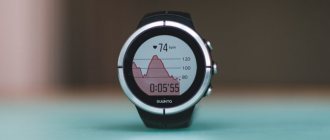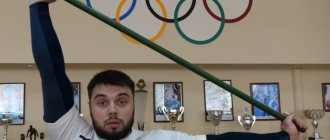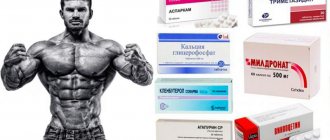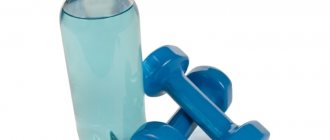Hot bath after exercise: how it affects the body
Overall positive - it helps the recovery process. “Proper recovery is as important as the training itself,” says Anastasia Yurkova, master trainer of X-Fit group programs in Russia. — No matter what goal you set for yourself—gain muscle mass, lose weight, or develop endurance—no fitness goal will be achievable without proper recovery.
This includes: passive rest, sleep (at least 8 hours), active recovery, proper and nutritious nutrition, as well as various procedures - massage, sauna and bath.” What's good about a bath? First of all, it helps normalize body temperature. “The bath stimulates either heat transfer when the water temperature is higher than body temperature, or heat production when it is cool or icy,” adds Ilya Voronin, a cyberneticist, specialist in restorative medicine and medical massage at the SportMedica clinic . “Many organs are involved in the cascade of thermoregulation reactions: skin, muscles, cardiovascular system, endocrine glands, lungs, kidneys, liver.”
According to Ilya Voronin, the most important effects of a hot bath are:
- decreased muscle tone, relaxation;
- improving fascia slip and ligament elasticity;
- reduction of muscle pain;
- decreased blood pressure;
- sedative effect.
When exactly should I go to the bath after class? “Within half an hour after an intense workout, the body enters a rapid recovery phase. At this time, the body strives to return to a state of homeostasis. The functioning of the cardiovascular system is normalized, hormonal levels return to normal, and ATP reserves are restored. The next phase is the slow recovery phase, and it is at this moment that it is best to take a bath,” explains Anastasia Yurkova.
Is it possible to sleep after training during the day?
In theory, yes, because even professional athletes do this. “Athletes who are in preparatory or recovery camps should sleep after lunch for 1-2 hours, since they need more rest time to form the slow-wave sleep phase and muscle relaxation,” says Oksana Khodorovich.
But there are difficulties: most often it is difficult to fall asleep immediately after a fitness class. “Working out activates our adrenal glands, and they release stress hormones: your post-workout sensations are equal to a cup of well-brewed coffee! Energy and positive mood are guaranteed. So you can sleep during the day if you can do it,” says Maria Komolova, master trainer of the federal network of X-Fi t clubs.
That's why experts don't recommend evening workouts just before bed. “The body needs about two hours for all processes to slow down and you are ready for sleep. A calm walk from the hall to the house can serve as a slowdown,” adds Maria Komolova.
As for daytime workouts, is it possible to sleep after them? Yes, but not for long. “If you are not a professional athlete and are not preparing for a competition, I recommend sticking to the first two stages of sleep - napping (5-10 minutes) and light sleep (about 20 minutes). Total - daytime sleep takes 30-35 minutes. Then the deep phase of sleep begins, during which the heart rate and breathing rate decrease, the parasympathetic nervous system turns on, and the muscles relax. Awakening during this phase can lead to decreased performance and bad mood,” says Oksana Khodorovich.
Another option is to replace naps with relaxation meditation. In the same 25-30 minutes you will get about the same benefit.
Hot, cold or contrast bath: which one to choose?
Although hot baths are most often used for recovery, doctors are positive about other types of this procedure. “With the right approach, you can get a lot of benefits from cold, ice and contrast baths too. In addition, the bath can be general (the whole body is immersed) or, for example, a foot bath (only legs up to the knees will be in the water), explains Ilya Voronin. “Immersion in an ice bath is practiced by some mixed martial arts fighters, wrestlers and CrossFit athletes.”
What are the benefits of such procedures? Short-term general cooling of the body leads to:
- a sharp spasm and subsequent strong dilation of skin vessels, a feeling of warmth;
- reducing residual tension in the muscles;
- restoration of normal respiratory rhythm;
- stimulation of the immune system;
- general cheerfulness.
But be careful: ice or cold baths do not reduce muscle pain (post-workout soreness). “Also remember that we are only talking about a quick dip in the bathtub or dousing from a bucket! Prolonged cooling negatively affects the condition and performance of the body and increases the risk of infectious diseases,” warns Ilya Voronin.
Athletes often use a contrast bath, that is, alternating hot and cold water. “They always start and end with a hot bath, and the difference in water temperature should be at least 10 degrees,” notes Ilya Voronin. “This option combines the benefits of a hot and cold bath; in addition, a contrast bath is considered an excellent “training” for the cardiovascular system.”
At home, a contrast bath can be replaced with a similar shower. But foot baths after training (as professional athletes do) can be easily repeated at home. “Foot baths are good because even local cooling or heating of the legs affects hemodynamics as a whole. Thus, a hot foot bath increases blood circulation in the lower leg by 6-7 times compared to rest, which reduces diastolic (lower) blood pressure,” adds Ilya Voronin.
What bath to take after different types of exercise? Let's take a closer look.
Is it possible to take a cold shower after training?
Home / Beauty and Health / Is it possible to take a cold shower after training?
In this article, I will tell you whether it is possible to take a cold shower after training.











